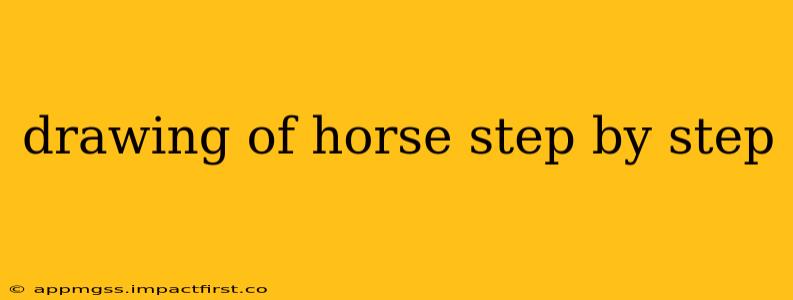Learning to draw a horse can seem daunting, but breaking the process down into manageable steps makes it achievable for everyone, from beginners picking up a pencil for the first time to more experienced artists looking to refine their technique. This guide will walk you through a simple yet effective method, focusing on capturing the horse's essential features and proportions. We'll also address some common questions aspiring equine artists often have.
Getting Started: Materials and Preparation
Before we begin, let's gather our materials. You'll need:
- Paper: A good quality drawing paper is recommended, but any paper will do for practice.
- Pencils: A range of pencils (e.g., H2, HB, 2B) will allow you to create different line weights and shading effects. An HB is a good all-around choice to start with.
- Eraser: A kneaded eraser is ideal as it's less likely to damage your paper.
- Sharpener: Keep your pencils sharp for clean, precise lines.
- Reference Image (Optional): While not strictly necessary for this basic guide, having a reference image of a horse can be extremely helpful, especially for beginners.
Step-by-Step Horse Drawing Guide
We'll simplify the horse's form into basic shapes to build a strong foundation.
Step 1: The Head
Begin by drawing a slightly elongated circle for the head. Add a smaller circle inside, slightly offset, to represent the muzzle. Connect these circles with a gently curved line to form the horse's neck.
Step 2: The Body
Underneath the head and neck, draw a large oval shape for the body. The oval shouldn't be perfectly symmetrical; it should be slightly longer and wider at the rear.
Step 3: Legs and Hooves
From the bottom of the body oval, draw four slender, slightly curved lines representing the legs. At the bottom of each leg, draw small ovals to represent the hooves. Remember that the horse's legs are not perfectly straight; they have gentle curves and joints.
Step 4: Refining the Shape
Now, we'll refine the initial shapes. Gently curve the lines connecting the head, neck, and body to create a smoother, more natural flow. Adjust the proportions of the legs and hooves to create a more realistic look. Add a small curved line at the top of the neck for the mane.
Step 5: Adding Details
Now it's time to add the finer details:
- Eyes: Draw small, almond-shaped eyes on the head, situated near the muzzle.
- Nostrils: Draw small, slightly flared nostrils on the muzzle.
- Ears: Add two pointed ears on top of the head.
- Tail: Draw a long, flowing tail extending from the rear of the body.
- Mane and Tail: Refine the mane and tail, adding individual strands of hair.
Step 6: Shading and Texture
Use shading to create depth and dimension. Observe where light and shadow fall on the horse's body and use lighter and darker pencil strokes to represent this. Pay attention to the musculature of the legs and the rounded forms of the body.
Frequently Asked Questions (FAQs)
How do I draw a horse's legs accurately?
Drawing horse legs accurately requires paying attention to their angles and joints. Start with simplified shapes like cylinders, then refine them to represent the muscles and tendons. Observe reference images closely to understand how the legs bend and connect to the body.
How do I draw different horse breeds?
Different horse breeds have distinct characteristics. Research the breed you want to draw and pay close attention to its unique features, such as body proportions, head shape, and coat type.
How can I improve my horse drawing skills?
Practice consistently! The more you draw, the better you'll become. Study anatomy, observe real horses, and use reference images to learn about proportions, musculature, and movement. Don't be afraid to experiment with different techniques and styles.
What are some common mistakes to avoid when drawing horses?
Common mistakes include inaccurate proportions, stiff poses, and neglecting details such as musculature and shading. Practicing consistently and utilizing reference images can help avoid these errors.
This step-by-step guide provides a foundation for drawing horses. Remember that practice and patience are key. Don’t be discouraged if your first attempts aren't perfect—keep practicing, and you'll steadily improve your skills!
